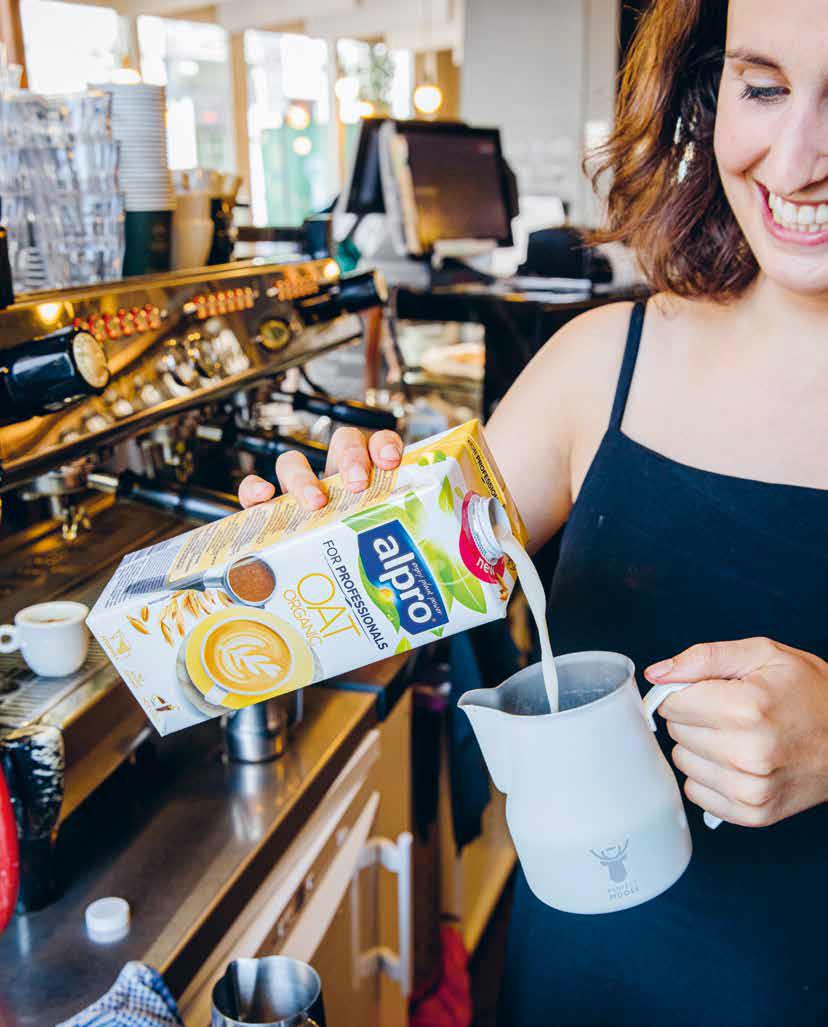In this blog we will talk about milk alternatives for your cappuccino. Until a few years ago, most cappuccinos were made with cow’s milk. Through recent times we as consumers have become increasingly aware about the sustainability of our consumption behaviour and the influence that our daily diet has on our health. The sustainability debate has entered our daily lives. We discuss climate change, biodiversity, ecological, footprint, CO2 emissions, etc. and the whole thing gives us cause to reflect on our food chain.
This is leading to many of us eating less meat, and when we do, we are more aware of what we are eating. But there is also a need to look into our consumption of cow’s milk. Soya milk, a vegetable-based alternative, is one of the popular solutions to reducing consumption of cow’s milk. Soya is a plant in the legume family (pulses), which means that the soybean ripens in a pod. The pod is not eaten; it is removed. We encounter soya frequently in our lives, often without being aware of it, and not only in the form of soy milk and soy sauce, etc. After all, soya is used a lot in animal feed, cookies, drinks, etc. Just as there are many species and varieties of coffee, there are also thousands of soybean varieties, each with its own application.
Benefits of soy
Let’s first take a closer look at the benefits that soy offers, because that question will no doubt arise often among your customers. Sustainability We are all aware that changing our consumption behaviour is becoming the great challenge of our future. Humans consume more natural resources than our planet can re-create. If all world citizens should maintain the same lifestyle as us Northern or Central Europeans do, humanity would need 4.3 planets to provide its needs. So things must change.
Vegetable-based food products offer part of the solution, because they have a much lower impact on the environment than their animal-based counterparts. Compared to cow’s milk, production of soy milk requires half as much land and a quarter of the amount of water, and the CO2 emissions are two and a half times less (or 40% of the amount). People who opt for a vegetable-based alternative also have a range of options other than just soy milk. Today’s market offers several vegetable-based variants, such as coconut milk, almond milk or oat milk.
Health and weight Obesity is also an increasingly significant problem in our society. Switching to soy products offers a partial solution to this too. Although soy milk contains fats, they are mainly unsaturated fats, which have a positive effect on our cholesterol levels. And it contains only a minimal amount of added sugar. For comparison: Alpro soy drinks contain, on average, 30% less sugar than most milk drinks with fruit or chocolate flavouring. And since 2008, Alpro has reduced use of sugar by 12% over its entire range of products.
Steaming soy milk
In itself, steaming soy milk does not differ much from doing so with cow’s milk. But soy milk actually reacts much faster to the slightest mistake you might make as a barista. Your steam technique must therefore be perfect to achieve a good result.
There are a number of points that you should pay particular attention to when steaming soy milk. This is because soy milk contains no lactose (the natural sugar in animal milk) and that means it develops differently during steaming than cow’s milk does. You will notice it can curdle very easily when you finally pour it into the espresso. This is partly due to the fact that soy milk contains a different type of protein. The curdling is a reaction in the soy milk to to the acidity of the coffee. This factor means that soy milk will react more in some coffees than in others.
Soy milk will react particularly faster in coffees that are classified today as speciality coffee, e.g. light-roasted African coffees, than in slightly darker-roasted coffee from Indonesian beans. Happily, you can still make a proper cappuccino with soy milk.
Tips & tricks
- Use a soy milk type designated for professional use – this variant has been specially developed for use in coffee. Apple extract is added to the soy milk, which makes the acidity higher, and the product reacts less quickly in your espresso.
- Store your soy milk in the refrigerator.
- Make sure your milk jug is clean and cool (always rinse it after use with cold water to avoid ever starting with a warm jug).
- Do not steam previously steamed soy milk a second time, just as you would not with cow’s milk.
- Steam the milk slightly less hot, since soy milk reacts even faster to an excessive temperature than cow’s milk. Stop by preference at 65 °C rather than 70 °C. You might think that your customers will find this lukewarm? But test it yourself. Drink a cappuccino with milk at 65 °C and you will find that it is a very pleasant, warm and drinkable temperature.
- Preferably use a coffee with a lower level of acidity.
- First brew your shot of espresso and then start steaming your soy milk, so that the temperature of your espresso has time to drop a little.
- Once your milk is steamed, you should swirl it in your milk jug by making a smooth circular movement. That’s how you ‘polish’ your milk and it will mix the different layers. Your milk will have a beautiful shine on the surface. Only stop swirling when you actually start pouring the milk into the cup. This is even more important with soy milk than with cow’s milk, since it will ‘split’ or separate more easily.
